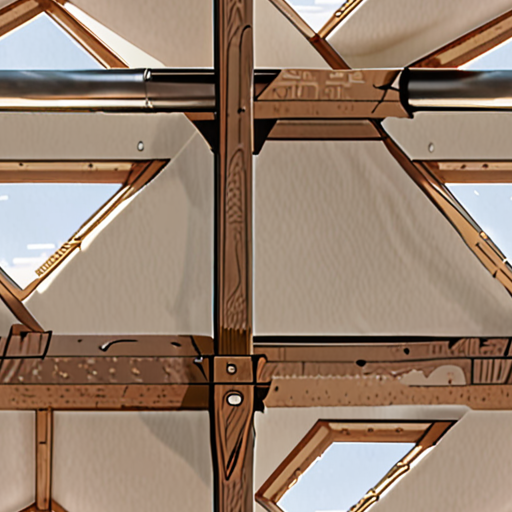Are you considering turning your underutilized attic space into a functional and comfortable living area? With the right approach, attic conversions can significantly increase your home’s value, provide additional storage, and even generate rental income. However, navigating the complexities of attic conversion ideas can be daunting, especially when it comes to understanding local building codes, assessing structural integrity, and determining the most cost-effective solutions.

The 7 and 7 Rule for Attics
The 7 and 7 rule is a guideline used by building professionals to determine whether an attic can be converted into a usable living space.
- At least half of a finished attic must have ceilings at least seven feet high.
- The space should also be a minimum of seven feet wide and 70 square feet.
This rule helps to ensure that the attic has enough headroom and space to accommodate furniture and other features, making it a comfortable and functional living area.
Benefits of Following the 7 and 7 Rule
- Increased functionality: By following the 7 and 7 rule, you can turn your attic into a fully functional living space that adds value to your home.
- Improved safety: A well-designed attic space with adequate headroom and space reduces the risk of accidents and injuries.
- Enhanced aesthetic appeal: A finished attic can become a beautiful and cozy retreat that complements the rest of your home.
Considerations Before Converting Your Attic
- Check local building codes and regulations: Ensure that your attic conversion complies with local building codes and regulations.
- Assess the structural integrity of your roof: Make sure that your roof can support the weight of a finished attic space.
- Determine the best layout: Plan the layout of your attic space carefully to maximize its potential and functionality.
Designing Your Attic Space
- Choose a style that suits your needs: Select a design that balances functionality with aesthetics and meets your lifestyle requirements.
- Select materials wisely: Choose durable and low-maintenance materials that complement your home’s style and architecture.
- Incorporate natural light: Add windows or skylights to bring in natural light and enhance the ambiance of your attic space.
Conclusion
By understanding the 7 and 7 rule and considering the factors involved in converting your attic, you can create a beautiful and functional living space that adds value to your home.
Converting an Attic on a Budget
When it comes to converting an attic into a functional space, many homeowners are concerned about the cost.
- One of the most cost-effective ways to increase the size and headspace of your attic is by opting for a roof dormer.
- This type of addition allows for more natural light and can be done at a relatively low cost compared to other types of renovations.
- Another option is to focus on upgrading the storage capacity of your attic.
- You can do some DIY upgrades on shelves and cabinets, or simply stack storage boxes and crates to maximize the available space.
- Additionally, consider repurposing items you already have at home, such as old furniture or containers, to save money on materials.
- For example, you could turn an old dresser into a storage unit or use plastic bins to store seasonal decorations.
- By getting creative with your storage solutions, you can make the most of your attic space without breaking the bank.
- Homeowners who want to take their attic conversion to the next level may consider hiring a professional contractor or carpenter to install custom shelving or built-in cabinetry.
- However, this option can be more expensive, so it’s essential to weigh the costs and benefits before making a decision.
- Ultimately, the cheapest way to convert an attic will depend on your specific needs and budget.
- By prioritizing your goals and exploring cost-effective options, you can create a beautiful and functional attic space that meets your needs and fits your wallet.
DIY Tips for Converting an Attic
While hiring a professional can be beneficial, there are many DIY projects that can help you convert your attic on a budget.
- Start by decluttering and organizing your attic space to determine what you need and what you can get rid of.
- Next, measure your attic space and create a plan for how you want to use the area.
- Consider installing shelving units or storage bins to keep items off the floor and out of the way.
- You can also repurpose old furniture or containers to create unique storage solutions.
- For example, you could turn an old ladder into a bookshelf or use a vintage suitcase as a storage container.
- Remember to always follow safety guidelines when working with power tools or climbing ladders.
- With a little creativity and elbow grease, you can create a beautiful and functional attic space that meets your needs and fits your budget.
Cost-Effective Materials for Attic Conversion
When it comes to converting an attic, choosing the right materials can make a big difference in the overall cost.
- Opt for affordable materials like plywood or MDF for shelving units and storage bins.
- Consider using reclaimed wood or salvaged materials to add a touch of character to your attic space.
- Another option is to use plastic bins or containers to store items, which are often cheaper than traditional storage solutions.
- Additionally, think outside the box when it comes to lighting fixtures – consider using string lights or lanterns to add ambiance without breaking the bank.
- By choosing cost-effective materials and getting creative with your design, you can create a beautiful and functional attic space that meets your needs and fits your budget.
Conclusion
Converting an attic on a budget requires careful planning and creativity.
By prioritizing your goals, exploring cost-effective options, and choosing affordable materials, you can create a beautiful and functional attic space that meets your needs and fits your wallet.
Whether you’re looking to add storage, increase headspace, or create a cozy retreat, there are many ways to convert your attic on a budget.
So why wait? Start planning your attic conversion today and discover the possibilities!

What is the Average Cost of an Attic Conversion?
The cost of an attic conversion can vary greatly depending on several factors, including the size of the attic, the type of materials used, and the level of complexity involved.
- Basic Attic Conversion
- Materials: £8,000 – £12,000
- Labor: £6,000 – £10,000
- Permits and inspections: £1,000 – £2,000
- Mid-range Attic Conversion
- Materials: £12,000 – £18,000
- Labor: £10,000 – £16,000
- Permits and inspections: £2,000 – £4,000
- High-end Attic Conversion
- Materials: £18,000 – £25,000
- Labor: $16,000 – $22,000
- Permits and inspections: £4,000 – £6,000
A basic attic conversion typically costs between £15,000 to £30,000, which includes the installation of insulation, flooring, and lighting.
A mid-range attic conversion can cost between £30,000 to £50,000, which includes the installation of windows, doors, and electrical wiring.
A high-end attic conversion can cost upwards of £50,000, which includes the installation of luxury finishes, such as hardwood floors and custom cabinetry.
It’s worth noting that these estimates may vary depending on the location, climate, and local building codes.
Homeowners who are considering an attic conversion should consult with a professional contractor to get a more accurate estimate of the costs involved.
Additionally, homeowners should also consider the potential return on investment (ROI) of an attic conversion, which can range from 70% to 100% of the initial investment.
Overall, the average cost of an attic conversion can vary widely depending on the scope of the project and the materials used.

Can My Attic Be Converted?
To determine whether your attic can be converted into a livable space, there are several factors to consider.
- The attic must meet minimum size requirements, typically around 70 square feet.
- The attic ceiling height must be at least five feet to accommodate standing room.
- The attic must have adequate ventilation and insulation to maintain a comfortable temperature and prevent moisture buildup.
- The attic must comply with local building codes and regulations regarding habitability and safety.
Evaluating Your Attic Space
Assess your attic’s potential by considering the following:
- Measure the attic’s dimensions and calculate its square footage.
- Check the attic’s ceiling height and ensure it meets the minimum requirement.
- Inspect the attic’s windows and doors to determine if they can be opened for ventilation.
- Examine the attic’s insulation and ventilation systems to ensure they are adequate.
Consulting Professionals
If you’re unsure about your attic’s convertibility, consult with professionals who specialize in home renovations and conversions.
They can assess your attic’s condition, identify potential issues, and provide recommendations for necessary repairs or upgrades.
Local Building Codes and Regulations
Familiarize yourself with local building codes and regulations regarding attic conversions.
This will help you understand the requirements and restrictions that apply to your project.
Permits and Approvals
Obtain necessary permits and approvals before commencing your attic conversion project.
This ensures compliance with local regulations and helps prevent costly delays or fines.
Additional Considerations
When planning your attic conversion, consider the following:
- The impact on your home’s structural integrity.
- The need for electrical and plumbing upgrades.
- The potential for noise pollution from neighboring homes.
- The importance of maintaining a safe and accessible entrance to the attic.
Do I Need a Permit to Turn My Attic into a Room?
To determine whether you need a permit to turn your attic into a room, it’s essential to understand the local building codes and regulations in your area.
- Contact your local municipality to inquire about the necessary permits for your attic remodel.
- A permit is typically required if you’re planning to:
- Add electrical wiring or ventilation systems.
- Change the structure of your home, such as knocking down walls or adding a dormer.
Before commencing your attic conversion project, consider consulting with a professional contractor or builder who can guide you through the permitting process and ensure compliance with local building codes.
Additionally, familiarize yourself with the National Electric Code (NEC) and the International Residential Code (IRC), which provide guidelines for electrical and structural modifications in residential buildings.
When working on your attic conversion, remember to always follow safety protocols and best practices to avoid potential hazards and ensure a successful outcome.
For more information on home improvement projects and DIY guides, visit our website at Home Ideas Finders .
Remember to check with your local authorities for specific requirements and regulations regarding attic conversions in your area.
By understanding the necessary permits and regulations, you’ll be well-prepared to tackle your attic conversion project and enjoy a safe and functional living space.

Lofts That Cannot Be Converted
In order to determine whether a loft can be converted, it’s essential to consider various factors, including the age of the house, the type of roof, and local building regulations.
- Houses built before the 20th century often feature traditional roofing systems that can be adapted for loft conversions.
- However, homes constructed between the 1920s and 1950s might have flat roofs or other types of roofing that are less suitable for loft conversions.
- Trussed roofs, commonly found in houses built during or after the 1960s, pose significant challenges due to their complex design and structural integrity.
- These trusses are typically characterized by their W-shaped frames, which support both the roof and the floor.
- Altering these trusses is a complex process that requires careful planning and execution, often involving the replacement of sturdier supports.
Additionally, certain architectural styles, such as those featuring exposed beams or intricate woodwork, may require specialized expertise to convert safely and effectively.
Before embarking on a loft conversion project, it’s crucial to consult with a qualified architect or builder who can assess the property’s unique characteristics and provide personalized advice.
Key Considerations for Loft Conversion
- Age of the house: Older properties tend to have more adaptable roofing systems, while newer homes may present greater challenges.
- Type of roof: Flat roofs, trussed roofs, and other non-traditional designs can impact the feasibility of a loft conversion.
- Local building regulations: Compliance with local laws and regulations is essential to ensure a successful and safe conversion.
- Structural integrity: Assessing the property’s overall stability and potential load-bearing capacity is vital to prevent costly repairs or even safety hazards.
Conclusion
While many lofts can be successfully converted, there are certain exceptions to consider. By understanding the complexities involved and consulting with experts, homeowners can make informed decisions about their loft conversion projects and achieve their desired outcomes.

0 Comments